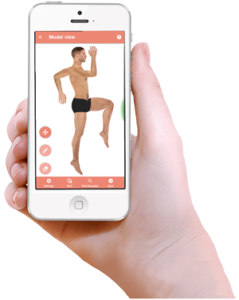Theoretical Constructs for the formation of Trigger Points
Abstract:
While the nociceptive influence of Trigger points (TrPs) is well known not much thought has yet has been given on the exact causes of why TrPs form. The underlying cause of TrP formation is the overworking of muscles. On the basis of the Sliding Filament Theory, it is concluded, that TrPs form because of the Actin-Myosin bond not uncoupling. This, in turn, is caused by the shortage of ATP in the muscle cell. On that basis, this paper presents four possible scenarios from the perspective of ATP demand and supply on how TrPs form:
- Overworking of muscles
- Prolonged mild contraction
- Constriction of blood supply
- Whiplash
The paper also offers a graphical representation of each of the scenarios.
Introduction
In Travell and Simons book, Myofascial Pain and Dysfunction: The Trigger Point Manual, they say that 75-95% of all human pain conditions arise from Myofascial Trigger points (1). For the uninitiated a trigger point is a knot in a taut band of muscle that can be very painful to touch.
However, most people are unaware of Trigger points, as they cause chronic pain in distant sites, far away from the original muscle where the TrP has formed. TrPs cause the muscle to shorten resulting in a chain reaction of stress to pull up or down the myofascial lines of the body. These myofascial links are similar to the SEN of Thai Massage or Chinese Medicine (2).
For example, the chain of fascia running up from the Anterior Tibialis to the ASIS (Anterior Superior Iliac Spine) along the Rectus Femoris are what some schools of Thai Massage call the SEN Itha/Pingkhala. A trigger point that forms on this SEN or any of the muscles forming the SEN pulls the fascial chain in both directions. This pulling results in tension on the tendons where the muscles attach to the bone. That tension fires sensory organs within the fascia, generating the feeling of pain far from the original site of the TrP.
While a lot has been written on how to remove these TrPs it is also critical to understand the various mechanism that causes the formation of TrPs and, therefore, allow practitioners to evolve methods for prevention of TrP formation.
The Physiology of Muscle and TrPs :
Muscle cells are typically cylindrical in shape a few microns wide and a few centimeters long. They are set within the collagenous network and have several specialized cells that help with healing and growth.
The key biomechanical component of a muscle fiber is formed by lengths of proteins called Actin and Myosin. These proteins form coupling links that are the fundamental mechanical structures of the muscle cell. The process of coupling creates contractions and uncoupling of these proteins create lengthening in the muscle fiber.
The process of coupling-uncoupling uses an energy molecule called ATP (Adenosine Triphosphate). One molecule of Glucose creates about 36 ATP molecules (3)which can be utilized by cells to maintain its cellular activity, coupling-uncoupling being one of them.
The contractile cycle of a muscle cell starts when the Actin and Myosin are in position for attachment. As calcium ions (due to an arriving nerve impulse) enter the muscle cell they cause the two proteins to attach and form a cross bridge. The cross bridge generates forces that cause the actin protein to bend and move in, in reference to myosin. This is where the ATP molecule enters the situation. It causes the Actin-Myosin cross bridge to break and with further hydrolysis causes the Actin to move back for reattachment if required. The ATP molecule is, therefore, fundamental to the release of Actin- Myosin muscle protein. If there is not enough ATP in the cell the contracted muscle will not release, and Actin/ Myosin fibers will stay locked in, as it happens in muscle death where rigor mortis occurs.
It is, therefore, clear that a TrP forms when the supply of ATP does not meet the demand in the muscle cell causing the muscle to fatigue and set itself into a somewhat permanent contraction.
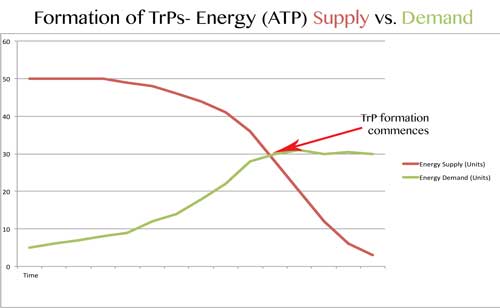
Theoretical Constructs of causative scenario in TrP Formation
By applying supply/ demand side possibilities to a muscle, we can theoretically create the possible scenarios that lead to TrP formation. It is also possible to predict how a curve depicting the supply and demand of ATP over time within a muscle cell will move. There are both supply side and demand side factors that make a Trigger Point occur. When the demand (red) drops below the supply (green) the formation of TrP commences (Figure 1).
They might start occurring on some filaments and by the time all ATP in the cell is exhausted all filaments in the muscle cell are locked. Following scenarios are being suggested as TrP forming events along with a graphical depiction of the same.
1. Over Working the muscles: Muscles need ATP to complete the contractile cycle, and there is a limited amount of ATP within the sarcomere for this purpose. Supply of ATP (using aerobic methods) to convert Glucose is not very rapid. Overworking cause the muscle cell to deplete its existing supply of ATP. Depending on the cardiovascular health of the individual the body will try to resupply ATP to the muscle cell as quickly as possible. However this process is slow and eventually all ATP is depleted, and Actin – Myosin cross-bridge is locked forming a TrP (Fig 1).
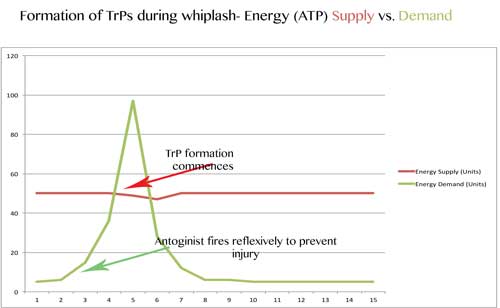
2. TrP from Whiplash injuries: During sudden and strong movement like those experienced in a car accident, the body can be forced in various directions quite rapidly. To prevent severe injury, the body reflexively pulls the body back using the antagonistic muscles. This reflexive movement is often quite strong as it needs to apply as much counter force to prevent the injury. At the moment as the muscles contract, they demand a large amount of ATP and quickly expend those within the muscle cell. The movement is so rapid that there is no time for the body to replenish the ATP resulting in the formation of TrP (figure 2).
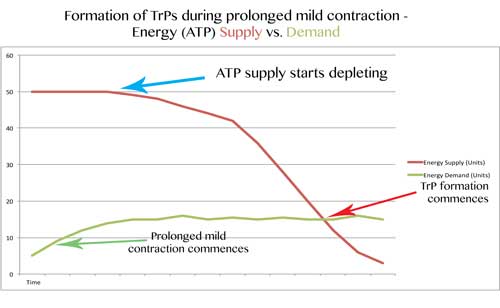
3. TrP from Prolonged contraction: This is one of the most frequent of all reasons. Typically an occupational hazard in our overcrowded lives. People who sit on desk hunched over the keyboards tend to collect them on the pectoral muscle in their chest. Prolonged mild contraction also uses ATP and expends energy. Also, this contracted muscle may also restrict the vasculature of the muscle body and, therefore, limit the supply of nutrients to the cell. Over time, the muscle expends its ATP store and body is unable to provide ATP to meet the demand and a TrP forms (figure 3).
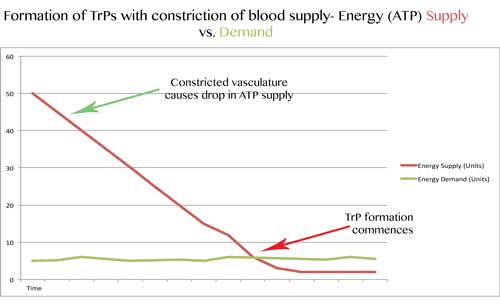
4. TrP formed by Constriction in Blood supply: This situation has been discussed in some minor detail to explain prolonged mild contraction in point 3. However, the formation of TrP for the constriction of blood supply can occur independently of any muscle contractile activity. This is because even though muscles are not being actively contracted they still use ATP albeit at a lower rate. In general, this is not an issue as resting supply of ATP in muscles exceeds the resting demand for ATP. However when the vasculature gets constricted, then the amount of ATP drops below the resting demand of ATP in the muscle cell causing a TrP to form (figure 4).
Conclusion
What can one do the prevent TrPs from forming and when they do how can one heal them.
- Eat healthy, exercise moderately and sleep well this improves cardiovascular condition and keeps the blood moving to the furthest cells of the body, so they are always well supplied with nutrients
- Don’t hold any position too long and if you happen to do so stretch and ensure that blood supply is restored to the constricted or contracted muscle.
- Work out the TrP with massage tools like a ball or coconut and then stretch.
Using these constructs, it is possible for a therapist to offer preventive advice to their clients so that they can lead a pain-free life.
References
- Simons DG, Travell JG, Simons LS. Myofascial Pain and Dysfunction: The Trigger Point Manual, Volume 1. Upper Half of Body. Second edition. Baltimore, Williams & Wilkins, 1999; pp. 11-93.
- Dorsher PT (July 2009). “Myofascial referred-pain data provide physiologic evidence of acupuncture meridians”. J Pain 10 (7): 723–31. doi:10.1016/j.jpain.2008.12.010. PMID 19409857.
- Rich, P. R. (2003). “The molecular machinery of Keilin’s respiratory chain”. Biochemical Society Transactions 31 (Pt 6): 1095–1105. doi:10.1042/BST0311095. PMID 14641005. edit
- Arnold, Jason. “Phases of Complete Glucose Breakdown.” Module 2 Part B Cell Function and Energetics. legacy.hopkinsville.kctcs.edu, n.d. Web. 24 Oct. 2014. <http://legacy.hopkinsville.kctcs.edu/instructors/Jason-Arnold/VLI/Module%202/m2cellfunctionandenergetics/m2cellfunctionandenergetics12.html>.
- Davies, Clair. The trigger point therapy workbook: your self-treatment guide for pain relief. 2nd ed. Oakland, CA: New Harbinger Publications, 2004. Print.
- Kushmerick, M. J.. “The Chemical Energetics of Muscle Contraction. II. The Chemistry, Efficiency and Power of Maximally Working Sartorius Muscles: Appendix: Free Energy and Enthalpy of ATP Hydrolysis in the Sarcoplasm.” Proceedings of the Royal Society B: Biological Sciences 174.1036 (1969): 348-353. Print.
- Muscolino, Joseph E.. Kinesiology: the skeletal system and muscle function. St. Louis, Mo.: Mosby Elsevier, 2006. Print.
- Travell, Janet G., and David Simons. Travell & Simon’s Myofascial pain and dysfunction: the trigger point manual. 2. ed. Philadelphia: Lippincott Williams & Wilkins, 19931999. Print


